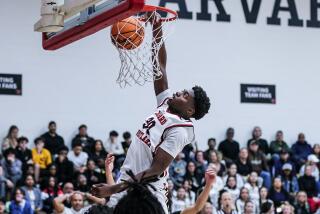Tempo Is Slowing Down in Boys’ Games
- Share via
Like so many basketball junkies, Rich Skelton pours over the newspaper box scores every morning, analyzing facts and figures.
And nearly 17 years after he coached San Clemente in a 6-4 loss to Whittier Sierra--the most infamous slowdown game involving an Orange County prep boys’ basketball team--Skelton sees a trend this season that will warm the hearts of the anti-shot clock legions.
“Maybe this year teams have begun to get more deliberate,” said Skelton, a measure of delight in his voice.
More than a decade after Showtime, slam and jam and run and gun became household words to every kid in a pair of high tops, Skelton says boys’ basketball might be on the verge of a turnaround, perhaps headed toward some hybrid of the up-tempo and slowdown games, where a shot clock would be unwarranted.
On the average, scores this season seem to be lower, and the deliberate, half-court game appears to be making a comeback.
Even Mater Dei, champion of the get-up-and-down-the-floor crowd, and the county’s top-ranked team, has resorted to a four-corner stall on a few occasions this season. The Monarchs stalled during their 50-41 loss to perennial national power Mouth of Wilson (Va.) Oak Hill Academy in the season opener. They also went to a brief stall at least twice in games at the Las Vegas Holiday Prep Classic, which they won.
A proponent of a shot clock, Mater Dei Coach Gary McKnight, admitted he went to the stall to keep those games close.
Skelton and others, such as Orange Coach Rich Bossenmeyer, think the shot clock is contrary to the nature of the game.
“Basketball is a game of defensive positioning and shot selection,” Bossenmeyer said. “By putting in a shot clock, it gives an advantage to teams with more athletic ability, because now it becomes a game of breaking people down one on one instead of playing team basketball.”
Bossenmeyer’s Panthers often win games by scoring in the 30s.
In 1993, Orange lost to Santa Ana Valley, 18-17. Bossenmeyer’s over-matched team sat back in a tight zone defense. Valley refused to attack and held the ball near the half-court line for much of the evening, taking a 12-8 halftime lead.
Good basketball or bad basketball? No doubt a shot clock would have changed the style of that game.
“With a clock, we would have forced them to shoot from the perimeter without a doubt,” Bossenmeyer said. “Whether that strategy would have held up is hypothetical.”
Bossenmeyer cut his teeth at Orange in another slowdown game, this one as a player. It was a 34-29 loss to Downey in the second round of the 1984 playoffs. Smaller and faster, the Vikings felt the much-taller Panthers would dominate the boards, so they held the ball. When Orange refused to budge, the game went into a major stall. Downey led at the half, 5-2.
A shot clock would have changed the way that game was played, too.
Bossenmeyer said the advent of a shot clock could bring about a situation similar to what sometimes occurs in girls’ games.
“You’ll see more teams laying back in zones because they basically can’t play with the team they are up against,” he said. “And you won’t pull them out of that zone even with a shot clock.”
Brian Mulligan, Capistrano Valley coach, was the point guard on Skelton’s San Clemente team in that game against Sierra, a highly ranked team that had a decided height advantage.
Mulligan spent most of the game holding the basketball in front of the Triton bench. Occasionally he played catch with teammate Rusty Adams. Sierra was content to sit back in its zone defense and watch. The final score set a Southern Section record for fewest points scored by a winning team.
“I wasn’t happy playing that way, even though the ball was in my hands all the time,” Mulligan said. “I think a shot clock would have added 30 points to each side’s score. Coach Skelton got the most out of that team with the advantage of not having a shot clock.
“There might be a lot of stubborn, old-time coaches who don’t want to put in a shot clock. . . . I’m inclined to agree with those stubborn, old-time coaches.”
More to Read
Get our high school sports newsletter
Prep Rally is devoted to the SoCal high school sports experience, bringing you scores, stories and a behind-the-scenes look at what makes prep sports so popular.
You may occasionally receive promotional content from the Los Angeles Times.






